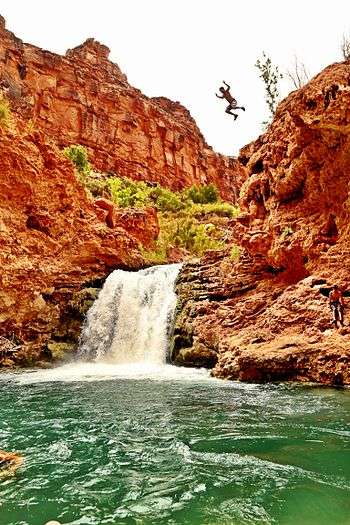Jumping platform
A Jumping platform is a naturally occurring or human-made surface for people to jump from. It is usually situated above sufficiently deep water, or above mats, a box-spring mattress, piles of empty cardboard boxes, or other soft landing surfaces, or they may be used together with other means of dampening the impact (such as for example, platforms for bungee jumping). Children often improvise platforms, either on a large scale (at abandoned quarries) or on a smaller scale (e.g. by moving a desk next to a bed, to jump onto the bed from the desk).
Platforms for cliff jumping

For cliff jumping, the platform is usually a simple clearing in the bushes and other vegetation along the cliff above a river, ocean, lake, or quarry.
Sometimes railway bridges and other bridges are used as platforms. They can sometimes be distances up to approximately 30 metres (100 feet) above the water.
Abandoned quarries, and deep ponds will often have platforms, whether by design, or by improvisation of the people in the community. For example, platforms will often be affixed to towers in abandoned rail yards, overlooking a deep pond.
Safety and traffic control
Many naturally occurring platforms are unofficial, and simply known among the children in a community. For example, the children are often trespassing on quarry land, or the like, when they use the platforms. Usually the locals check the water to make sure it is deep enough and free of clutter, but there is always the danger of a dead fish or beverage can, bottle, branches, or the like floating near the surface of the water. Bad angle of entry can also cause injury even in the absence of clutter (e.g. broken bones or re-arrangement of internal organs from the impact of the water itself, if landing crooked). Being knocked unconscious by the impact can also lead to drowning.
Technique
For cliff jumping, there are several techniques that can be utilized. The main technique involves landing in a pencil shape typically with hands at the sides or above the head. Keeping limbs in results in a freer and more painless entry. Pointed toes and closed mouth also assist in a smooth jump. Some prefer to jump with shoes or sandals, while others jump merely barefoot or naked.
For larger jumps (12 metres (39 ft) +), the angle of entry is critical. To ensure that you always enter the water vertically, it is proper to jump leaning slightly forward, keeping your point of entry in view. Extend your arms for balance. As you fall, gradually tuck in your arms, and bring together your legs. A gradual backward rotation throughout the jump will bring you from your initial forward position to complete a vertical entry. Common errors include backward over rotation and not tucking in arms or legs. Keep legs straight with a slight bend at the knees. Locking your legs when taking the pencil shape will cause impact on the knees. Generally, the highest jump that should be attempted is 30 metres (98 ft).